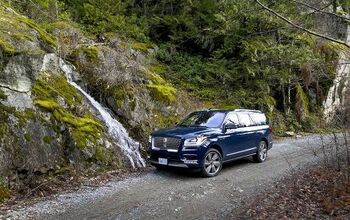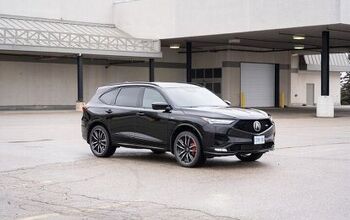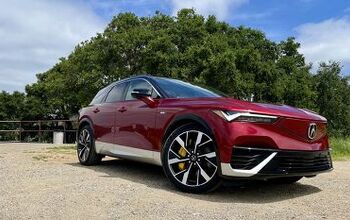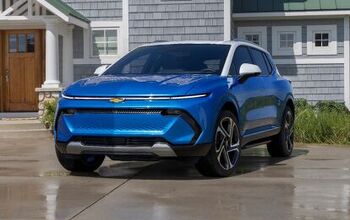2011 Lincoln MKX Review – First Drive
It seems that you need to have a luxury branded mid-size crossover to succeed in the car biz these days. Since it’s introduction in 2006; the Lincoln MKX has proved to be a hot seller for the brand, despite offering just a single engine and transmission (in this case a 265 horsepower 3.5-liter V6 and six-speed automatic). Yet the MKX’s combination of a sturdy unibody design, surprisingly good driving dynamics and high feature content, made it a surprising hit.
FAST FACTS
| 1. Along with a new look, the 2011 MKX gets a new 3.7L V6 engine with 305-hp (up 40-hp) and 280 ft-lbs of torque. |
| 2. Fuel economy has also improved with a best-in-class 19/26-mpg (city/hwy) rating for front-drive models compared to 17/23-mpg for last year’s MKX. |
| 3. Along with the new MyLincolnTouch infotainment system other new features for 2011 include Adaptive Cruise Control and Blind Spot Monitoring. |
| 4. The 2011 Lincoln MKX starts at $39,145. |
As a result, for 2011, with the Mercury brand now gone, Lincoln hopes that by adding a raft of upgrades it can further increase the MKX’s popularity, not only among Ford faithful but also by gaining conquest customers – people that perhaps would have previously considered vehicles like the Lexus RX350. Question is, do these upgrades go far enough? During an early preview drive of the 2011 MKX in Washington D.C., Autoguide did it’s best to find out.
“UNIQUE” STYLING
From a styling aspect, the 2007-2010 MKX was a curious blend of 1962 Continental, 1995 Town Car and modern crossover SUV, thanks to it’s full width front grille and LED taillight assembly that ran across the rear hatch opening.
For 2011, the MKX adopts the current Lincoln corporate profile, with a much more aggressive nose profile that apes the MKT. According to chief engineer Elaine Bannon, everything forward of the A pillars is new and the effect is quite striking, with a look that is both regal yet somewhat sinister. Out back the taillight panel has also been revised – the lights are now segmented, rendering the vehicle’s rump somewhat less busy in appearance, but amid a sea of generic cars on stilts that clot our modern highways, a still somewhat signature look. But it’s inside where the changes are most notable.
TOUCHING FEATURES
Perhaps the biggest is “MyLincolnTouch” which uses command screens, both in the center stack and instrument cluster. For the former, there’s an 8-inch liquid crystal display which contains controls to the vehicle’s info/entertainment system and climate control, activated purely by finger touch – hence the name. In addition, there are steering wheel-mounted controls that can perform all of the same functions. Fetishists will also delight in the new sound volume and fan speed controls, located below the screen, that also respond purely to finger input.
Moving to the instrument panel, flanking the gauges are two more LCD screens – the left one containing aspects such as odometer mileage, fuel economy and specific settings, while the right one allows the driver to interface with the onboard multi-media technology. As befitting a current Lincoln product, a THX sound system is included, as is the latest version of the Ford’s SYNC voice command system, activated by buttons in the steering wheel, plus a new first – High Definition radio.
The info/entertainment system is one of the least fussy we’ve encountered on a luxury branded vehicle of late, which should bode well for Lincoln’s target audience, especially considering that on many competitors, it’s getting harder and harder to perform basic vehicle functions such as changing cabin temperature or selecting music.
In terms of feel and ergonomics, much of what we liked about the old MKX is still evident inside, including a surprising amount of head and second row rear legroom. Big improvements have, however, been made when it comes to the quality and finish of the cockpit. A leather-stitched dashboard is a new feature; blending in with the revised center stack. Tasteful applications of chrome trim and either Olive Ash or Walnut Swirl woodgrain, lend a classy look. Leather stitching is also carried over to the door panels while softer touch armrests add to the feeling of comfort and serenity.
Even the seats are revised, with a new signature ‘Tuxedo’ pattern. They’re decently supportive, with good rake and lumbar adjustment and combined with the available tilt and telescopic column fitted to our tester it’s easy to adopt a sound driving position.
FASTER, SMOOTHER
Under the skin there are also notable changes, the most obvious being a new 3.7-liter V6 engine. With twin independent variable cam timing; the result is 305 horsepower a 6500 rpm and 280 ft-lbs of torque at 4000. Thanks to a lower idle speed (600 rpm), fuel shut-off and a variable-displacement power steering pump, the engine is notably more thrifty than the old 3.5 and Lincoln claims best in class fuel economy at 19 miles per gallon city/ 26 highway on front-drive models.
During our drive route, much of which consisted of stop and go street driving and busy highway merging, we weren’t able to quite manage that with our numbers coming up as 17.5 mpg city and around 24-mpg highway. That’s still notably better than some competitors while essentially matching our observations with the hallowed Lexus RX350.
Teamed with the engine is Ford’s six-speed automatic, with a manual select shift feature, though given that this powertrain combination provides strong, satisfying acceleration and ample power under nearly all traffic conditions, we can’t really understand why Lincoln uses awkward buttons on the shift lever for manual operation. A version of the MKS paddle system would just work so much better in this rig.
UPGRADED SUSPENSION BOTH SOFTER AND SPORTIER
Other engineering changes include greater attention to reducing NVH (noise, vibration and harshness), plus revised chassis and suspension tuning includes the adoption of new springs, shocks and different sway bars. The result is an MKX that is noticeably quieter and even smoother riding than before. Hit a bump and the vehicle seems to almost glide over it, while interior hush ranks at an all time high. You can barely hear anything and at times the engine’s throng is so muted, you’d swear there’s a gas turbine under the floor.
Yet this coddling doesn’t come at the expense of handling. One of the things we liked about the old MKX was its good steering feel, tight turning radius and surprising cornering capability. Thanks to new tires mounted on standard 18-inch wheels, grip is noticeably better than before and even in base front-drive form, the MKX feels surprisingly neutral. Braking modulation has also been improved and feel through the pedal is strong and satisfying, unlike many modern luxury vehicles, which aim to numb the senses in every which way.
THE VERDICT
Calling the 2011 MKX new is a bit of a stretch (technically its more like a massive mid-cycle update), but Ford has engineered enough changes to make it not only stand apart from its predecessor, but also to make it harder for the competition in this segment.
Although the Lexus RX350 continues to be the perceived benchmark, the 2011 Lincoln MKX, with it’s combination of a smooth, powerful V6, nicely appointed interior, good road manners, the easy-to-use MyLincolnTouch system and the addition of other high-tech content, might just give it a real run for its money. Pricing starts at $39,145, but even with all-wheel-drive and high zoot Limited trim, you’re still looking at south of 50 large and in this hotly contested segment, that should bode well for Lincoln’s strategy of reeling in conquest buyers from other midsize luxury crossovers.
RELATED READING
2010 Lexus RX350 Review
2008 Buick Enclave CXL Review
2010 Cadillac SRX Luxury AWD Review
2009 Infiniti FX35
2009 Infiniti FX50
2010 Volvo XC60 First Drive
LOVE IT
- Strong V6 engine
- Class-leading fuel economy
- Well-equipped and more luxurious interior
LEAVE IT
- Polarizing front-end styling
- Manual shift feature a waste of time
- Relatively heavy
More by Huw Evans






































Comments
Join the conversation